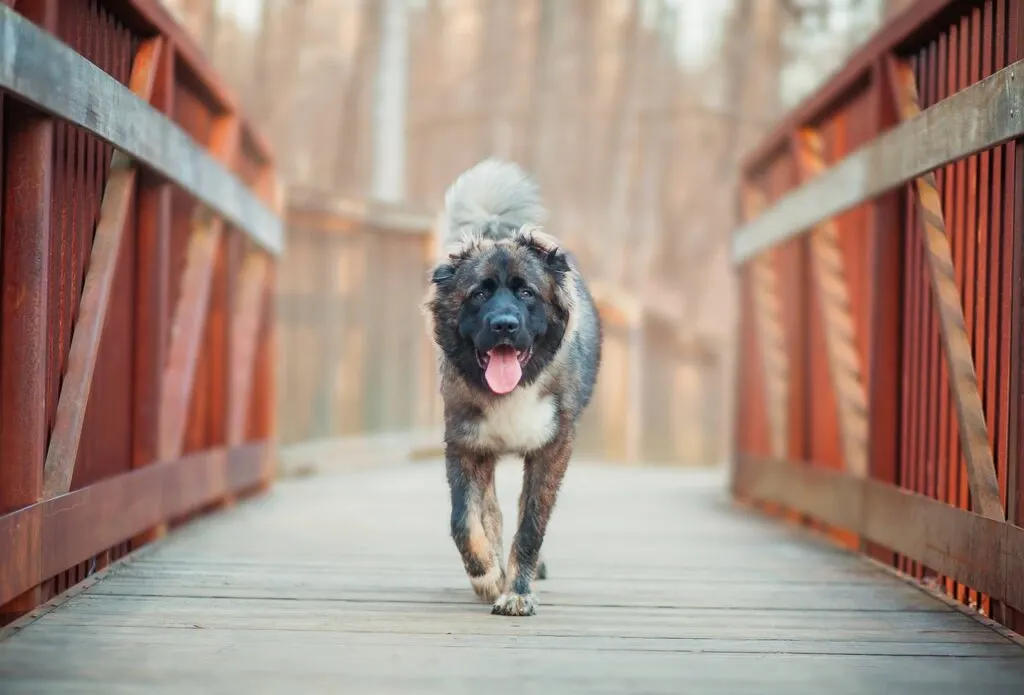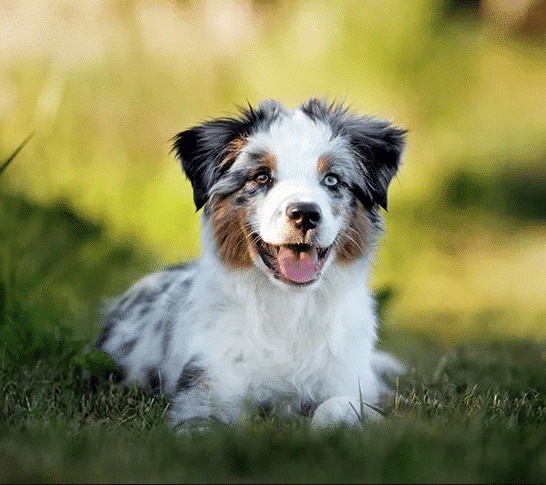Caucasian Shepherd Dog Breed Information
|
Prefer listening over reading? We got you covered!
Getting your Trinity Audio player ready...
|
Originating from the Caucasus region, the Russian Bear dogs were bred to safeguard flocks of sheep and homes. Fearless and highly territorial, they are known to stand up against predators like bears and wolves.
Their independence can make training challenging. With proper obedience training and consistent guidance, these massive guardian dogs can become well-behaved family pets. Contrary to popular belief, dogs of this breed can adapt to apartment living. Just make sure their exercise needs are met.
Quick Facts
Origin: Caucasian Shepherds originate from the Caucasus region.
Size: They stand 24-30 inches tall at the shoulder. Caucasian Shepherds weigh between 110-220 pounds.
Breed Group: Caucasian Shepherds belong to the working dog group.
Lifespan: Their average lifespan is 10-12 years.
Coat: They have a dense, double coat that can be cream, gray, fawn, or red in color.
Temperament: Caucasian Shepherds are known for being fiercely protective, loyal, and highly territorial.
Exercise Needs: They require a substantial amount of physical activity, needing at least 60-90 minutes of exercise daily.
Training: Early socialization and training are essential, although they can be somewhat independent-minded learners.
Health: While generally robust, they can be prone to health issues such as hip dysplasia, joint problems, and bloat.
Caucasian Shepherd Dog Breed History
The history of Caucasian Mountain Dogs dates back more than 2,000 years. This large dog breed is believed to have descended from wolves, Mastiffs, and sheepdogs that migrated from Tibet.
These dogs were bred by shepherds in the Caucasus Mountain region. They used these dogs to protect their flocks and homes. They are highly territorial and fearless, even when faced with bears or wolves.
Did You Know?
| 1 | 2 | 3 | 4 |
|---|---|---|---|
| The Caucasian Shepherd Dog is one of the ancient Molossian breeds. It has been discovered in ancient Mesopotamia through archaeological evidence. | In East Germany, Caucasian Shepherds were employed for border patrol along the Berlin Wall. They were adopted by German families after the wall’s collapse. | In Warsaw, there’s a story about a man who bought what he thought was a Caucasian Shepherd puppy from an eastern border trader. He later discovered it was actually a young bear. | Many kennels have Caucasian Shepherd dogs in various colors. The FCI standard rules out black, liver (brown), and blue as undesirable colors. |
Physical Characteristics
With its thick double coat and impressive size, the Caucasian dog breed is known for its physical strength and protective nature. These dogs have a watchful and protective personality, making them excellent guard dogs. They are wary of strangers but devoted to their families.
Caucasian Ovcharkas are considered a giant breed. Their heights range from 23 to 30 inches, and weigh between 99 to 170 pounds. They have a medium-length double coat that comes in various colors. Coat colors include agouti and white, black and gray, cream, fawn, gray, grizzle, red, rust, sable or white with/without white markings.
| Characteristics | Care |
|---|---|
| Watchful and protective personality | Requires early training & needs to be properly socialized |
| Wary of strangers but devoted to family | Moderate exercise needs |
| Used historically to guard property & livestock | Regular grooming required |
| Variations in appearance based on region | Drooling level is fairly high |
| Selective breeding by Soviet breeders for desired qualities |
Temperament and Personality Traits
When considering a Caucasian Ovtcharka, you’ll appreciate their watchful and protective personality. They are known for being highly territorial and fearless. They are willing to protect their loved ones from any threat, even bears or wolves. Their intelligence is evident.
It’s important to note that they have a natural distrust of strangers and other animals. It can lead to aggression if not properly trained. It’s crucial to prioritize qualities such as being quiet, low-energy, calm indoors, and having good manners when choosing a dog for an apartment.
Training and Socialization of Caucasian Ovcharka
Training and socializing Caucasian Shepherds can be challenging due to their stubbornness and independence. It is crucial for overcoming their apprehension and avoiding aggression. This breed can be a challenging choice for a first-time dog parent.
Early socialization is important to help them feel more comfortable in various situations. Positive reinforcement training methods work best with these intelligent but strong-willed dogs. Consistency is key when giving commands. Seeking professional help can be beneficial for first time dog owner.
It’s important to establish firm boundaries and provide clear guidance. It will help them understand what is expected of them.
Common Health Issues
One common health issue in this particular breed is hip dysplasia. It can cause pain and mobility problems. This condition occurs when the hip joint doesn’t develop properly, leading to instability and damage.
Here are three important things to know:
- Genetic predisposition: This issue has a strong genetic component. It’s crucial to choose a reputable breeder who performs health screenings on their breeding dogs.
- Symptoms and diagnosis: Signs include limping, difficulty getting up or climbing stairs, and decreased activity levels. A veterinarian can diagnose the condition through physical examination and X-rays.
- Treatment options: Treatment ranges from lifestyle modifications such as weight management and exercise moderation to medication for pain relief. In severe cases, surgery may be necessary to improve the dog’s quality of life.
Understanding these aspects of hip dysplasia can help you better care for your dog and ensure their overall well-being.
Diet and Nutrition
Proper nutrition is essential for maintaining their overall health and well-being. Large dog breeds need a well-balanced dog food that is suitable for their life stage.
Caucasian Shepherd Puppy
If you have a puppy, it’s recommended to feed them puppy food formulated for large-breed dogs during their rapid growth phase.
Adult Caucasian Shepherd
For adults, two meals per day are sufficient. It’s important to prevent obesity in these dogs, so lean diets are recommended. Obesity can increase the risk of joint problems like hip and elbow dysplasia. To encourage slow eating and prevent gulping down food too quickly, you can use slow feeder bowls.
Remember to consult with your veterinarian regarding the type and amount of food to feed your dog. Remember that individual needs may vary.
Exercise and Activity Needs
Exercise is crucial for maintaining the health and well-being of your pup. These large and powerful dogs have moderate exercise needs. They require at least an hour of physical activity per day.
Here are three important aspects to consider when it comes to exercising your dog:
Physical activities
Engage in activities such as walks, hikes, or playing fetch to keep your dog physically active. These exercises help burn off energy and prevent obesity.
Mental stimulation
Provide puzzle toys and nose work games. Engage in training sessions to challenge their intelligent minds. Mental stimulation is just as important as physical exercise for these intelligent dogs.
Leash or fenced area
Due to their protective nature, it’s essential to walk them on a leash or in a securely fenced area. This helps ensure their safety. It also prevents any potential conflicts with strangers or other animals.
Grooming and Coat Care
Grooming and maintaining the coat of Caucasian Mountain Dog requires regular brushing to manage shedding. These dogs have a thick double coat that sheds a lot, especially during spring and fall. By regularly grooming, you can help reduce the amount of loose hair in your home.
- It is important to use a tool that is suitable for their coat type, such as a slicker brush or undercoat rake.
- Bathing your dog should be done occasionally to keep their coat clean and healthy. Pay attention to their ears, teeth, and nails as well.
- Cleaning their ears regularly and brushing their teeth daily will help prevent any potential issues.
- Trimming their nails on a regular basis is also necessary to keep them at an appropriate length. After a long walk check your dog’s paws and clean them if needed.

Bringing Home a Caucasian Shepherd
Living arrangements for large dogs can be challenging due to their size and protective nature. These dogs require ample space to roam and explore. Apartment living is less than ideal. Here are some factors to consider when it comes to their living arrangements:
- Space: Dogs of large size need a home with a large yard or access to open spaces where they can run and play.
- Security: These dogs have a strong protective instinct. It’s important to have secure fencing or containment measures in place.
- Socialization: Proper socialization is crucial for this breed. Regular exposure to different people and situations will help them become more comfortable.
Choosing and Caring for a Caucasian Shepherd Puppy
When choosing and caring for your puppy, it’s important to consider their size and protective nature. These dogs are known for being large and strong. Make sure you have enough space to accommodate their size.
They are also highly protective of their families. This means they may not be suitable for households with small children or other pets. It’s crucial to provide them with early training and socialization. This will ensure they grow up to be well-behaved and friendly adults.
Regular exercise is necessary to keep them healthy and prevent obesity. These puppies require dedicated care and attention. If you’re prepared for the responsibility, they can make loyal and loving companions.
Conclusion
When considering a Caucasian Shepherd Dog as a pet, it is important to understand their history, physical characteristics, temperament, and training needs.
Despite their stubbornness and independence, with proper training and socialization, they can adapt well to apartment living. However, their exercise and mental stimulation requirements should not be overlooked.
Regular grooming and routine veterinary care are necessary for their health and well-being. With the right owner who is experienced and committed to providing the necessary care, this massive breed can make a loyal and affectionate companion.






























